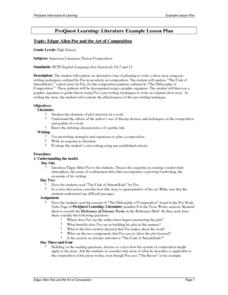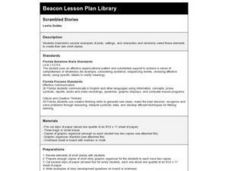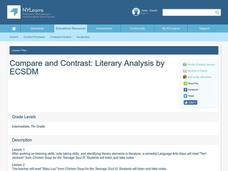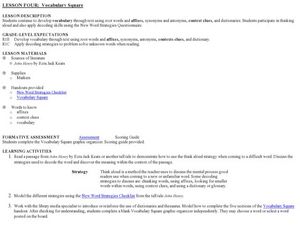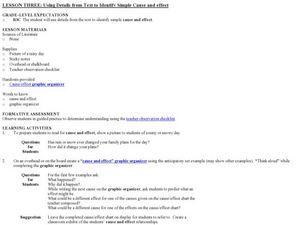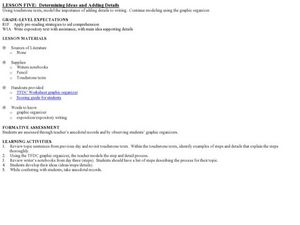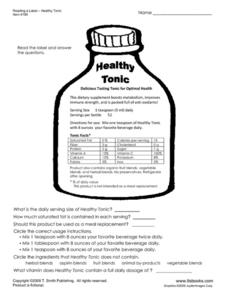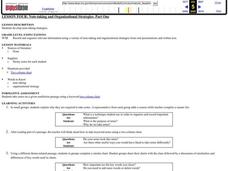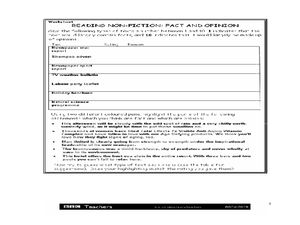Curated OER
Writing Fables
Students develop a working skill of using graphic organizers for writing. The lesson notes that the best kind of organizer is one that is engaging to the appropriate audience. The assessment follows the rubric given in the lesson.
Curated OER
Map Skills
Do you need to practice map skills? Children with a range of abilities will complete a KWL chart about maps, practice important map vocabulary and then read a few pages from their textbook. They will use their vocabulary words and...
Curated OER
Edgar Allen Poe And The Art Of Composition
High schoolers evaluate several works by Edgar Allen Poe based on the criteria in his essay, "The Philosophy of Composotion" Their analysis is documented using a graphic organizer. Learners begin the pre-writing process for their own...
Curated OER
Scrambled Stories
Character development, setting, and plot? Sounds like the makings of a good narrative story. Young authors read and analyze several narrative examples, and then they use what they know to pen an original composition. They work both in...
Curated OER
Reader Response
Fifth graders reflect upon different concepts of Language Arts while reading literature. In the novel Tuck Everlasting, by Natalie Babbitt, the characters discover a spring of eternal youth. After reading the first several chapters of...
Curated OER
Responses to Literature
Middle and high schoolers hone their writing skills by reading Rikki-Tikki-Tavi and the poem Sarah Cynthia Sylvia Stout Would Not Take the Garbage Out. They fill out a graphic organizer (included here), and use the organizer to write an...
Curated OER
Compare and Contrast: Literary Analysis
Seventh graders are able to use active listening skills, take notes and identify literary elements of a short story. They use/create graphic organizer, compare/contrast literary elements from various stories and compare and contrast traits.
Curated OER
Find Figurative Language
Meet with the school library specialist and work together to plan a visit and presentation on figurative language. After defining and examining examples of targeted terms, the class travels to the library where the SL has collected...
Curated OER
Entrepreneurship
Give your class a copy of USA TOday to read through and find articles about companies that offer goods or services. They create a graphic organizer and list the business, product, want or need fulfilled of the companies found in the USA...
Curated OER
A Lesson in Vocabulary with El Bronx Remembered
After reading El Bronx Remembered by Nicholasa Mohr, learners complete a KWL graphic organizer based on vocabulary from the novella. A SMARTboard presentation is a good resource for reviewing the vocabulary, as well as the triple-entry...
Curated OER
Writing Process- Narrative Writing
Graphic organizers are a wonderful tool for young writers to use to help them get their thoughts in order for a piece of writing. Here, learners are coached on what a piece of narrative writing is, and how they must have a distinct...
Curated OER
Compare and Chart the Stories
Elementary schoolers engage in a literature study. They make comparisons of two different versions of a story using a graphic organizer. Using the text and pictures elementary schoolers investigate three elements from the story. Then,...
Curated OER
Vocabulary Square
Examine the use of vocabulary squares to aid in reading comprehension. Assessment and graphic organizer included.
Curated OER
Exploring Figurative Language in Fiction and Nonfiction
A reading of Pat Street's There's a Frog in My Throat launches a study of figurative language. Using a pocket chart, display one phrase containing figurative language. Class members choose the best explanation from three choices offered....
Curated OER
Lesson Three: Using Details from Text to Identify Simple Cause and Effect
Third graders identify cause and effect. In this cause and effect lesson, 3rd graders use a graphic organizer to predict effects for certain causes. They read a non-fiction text and put sticky notes marking causes and effects.
Curated OER
Determining Ideas and Adding Details
A handy TFDC (topic/fact/detail/conclusion) graphic organizer (included) allows young writers to outline and record their main ideas and supporting details in the prewriting phase. They then continue to add details to the topic sentences...
Curated OER
Sentence Train
What child doesn't like trains? Use this fun idea to practice writing. Young readers learn to write complete sentences by using a train graphic organizer made out of construction paper. Each section of the train (engine, boxcar, and...
Curated OER
Sense of Hearing
Create a graphic organizer to review parts and systems of the body, then present a new topic. Special education students grades 3-5 learn about the sense of hearing. They draw parts of the ear, sign a song, read Perk Up Your Ears, and...
Curated OER
Healthy Tonic: Label Reading
For this factual text worksheet, 6th graders read a bottle label for a delicious tasting tonic for optimal health. Students must read the factual text and answer the six reading comprehension questions that follow.
Curated OER
Note-Taking and Organizational Strategies
Students explore note taking. For this study skills and nonfiction comprehension lesson, students complete a two column main idea chart while reading a nonfiction passage.
Curated OER
Reading Non-Fiction: Fact and Opinion
In this reading non-fiction worksheet, students complete a graphic organizer, rating on a scale of 1-10 whether given types of text would be more opinion or fact. Students then highlight parts of statements indicating fact or opinion.
Curated OER
Reading Selection Content Worksheet
In this literary elements worksheet, middle schoolers read chosen literature and then complete the provided graphic organizer by listing key words, main ideas, and summarizing the selections.
Curated OER
My Personal Cam Jansen Reading Log
In this Cam Jansen worksheet, students fill out a graphic organizer for the book, pages, date started, date finished, and recommendation for reading Cam Jansen books. Students do this for 7 books.
Curated OER
Making and Breaking the Grid
High schoolers examine the grid in terms of a method of organization in our society as well as graphic design. In this "Making and Breaking the Grid" lesson, students design solutions to common problems and draw conclusions about...




